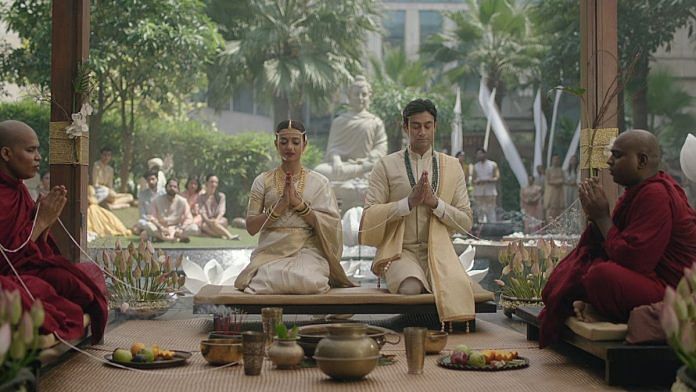Mumbai: Manjushree, a Buddhist techie from western Maharashtra working in Europe, fell in love with her European colleague Robert. Robert liked Manjushree, given her penchant for travel. For years, they kept their feelings to themselves while working on a project together. When they finally expressed their desire to be together, the couple’s parents gladly agreed. Robert flew to India with his family last year, agreeing to marry in the Buddhist tradition. There was no official engagement, just a direct wedding.
“I knew Robert for many years but was hesitant, says Manjushree, who had been in a relationship with an ‘upper-caste’ Indian man many years ago. “But when the discussion started about marriage,” she says, “my Buddhist religion (and Dalit background) was seen as a hindrance.”
While discussing the modality of marriage, Manjushree’s former partner had insisted on Hindu rituals (or Pheras). “His parents outrightly rejected me as a daughter-in-law and threatened to disown their son. To my utter shock, their son accepted their decision, and, while breaking up, told me that if I was any caste other than Buddhist, he could have convinced his parents.”
She is confused how a well-educated, 21st-century techie like her faced such discrimination. “When will our society grow? Thankfully, now I have a partner who believes in equality and respect.”
As part of Buddhist marriage rituals, Manjushree and Robert took an important pledge – that they would treat each other with respect.
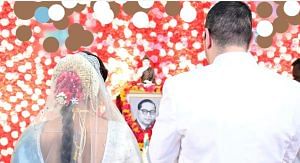
“I see Pallavi [Menke], and I see me,” says Manjushree while referring to Radhika Apte’s Dalit Buddhist character from the fifth episode of Amazon Prime Video’s Made in Heaven season 2.
Many Manjushrees have experienced what Pallavi did in the Neeraj Ghaywan-directed episode – an educated, accomplished woman facing overt and covert caste discrimination.
But the defining moment came in the concluding scene.
A bride wearing a radiant off-white saree, Kolhapuri gold saaj jewellery, and a white flower garland around her doughnut bun hair slowly walked through a crystal-clear pond full of white lotuses, reaching the marriage stage in front of a 10-foot-tall Buddha statue. The bride and groom then lit the candles for Bhim Rao Ambedkar and Buddha, holding one end of a white cotton thread that ran through a water pot as Buddham Saranam Gacchami Panchshil played in the background.
This mesmerising Buddhist wedding sequence has turned out to be special, never seen before on the big or small screen in India. It has become the talk of the town, with the video clip going viral across social media platforms.
The only recent real-life Buddhist wedding that comes to mind is Akash Anand’s marriage to Pragya Siddharth. Akash is the nephew of Bahujan Samaj Party (BSP) chief Mayawati, while Pragya is the daughter of BSP leader Ashok Siddharth. According to a guest, the grand wedding occurred at a sprawling convention centre in Gurugram in March, in the presence of (the venerated) Chandrama Bhante and four other monks.
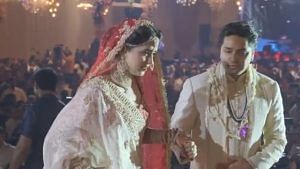
Imagine the irony. Despite being a prominent religion in India and Asia during the Mauryan Period, Buddhism declined and remained confined to the Northeast until Ambedkar’s historic conversion. We saw Hindu, Muslim, Christian and even Parsi weddings but never witnessed Buddhist weddings in Indian popular culture.
Certainly, there is a lot of curiosity around the tradition of Buddhist weddings, thanks to Ghaywan’s work. So, how does the ceremony take place in real life? And how did this tradition start?
Also read:
Ambedkar and Buddhist Marriages
Ambedkar converted to Buddhism in Nagpur, Maharashtra, in 1956, with lakhs of Dalit followers. But not before laying the foundation and documentation of the Buddhist religion, and its customs and rituals, for the converts to follow. He maintained that “The principles preached by the Lord Buddha are immortal. But the Lord Buddha did not make such [a] claim. There is a provision for change with the change of time. Such generosity is not found in any religion.”
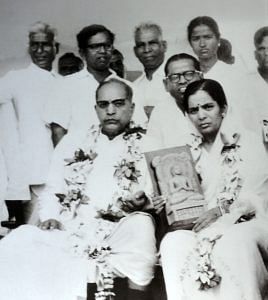
Days before the conversion, Bhau Kardak, a school headmaster, wrote a letter to Ambedkar asking for guidance on his marriage. He wrote, “Naturally we want to solemnise our marriage according to Buddhist religion. There is no better authority save you to guide us in this respect. Young educated Buddhists like us should lay down the precept and strengthen our movement.
Ambedkar explained in his reply, in lay language, how Buddhist marriage rituals should be conducted:
“The Buddhist Marriage ceremony is simple. There is no home (havan), and there is no Saptapadi [saat pheras that Pallavi’s in-laws were keen on]. The essence of the ceremony lies in placing one earthen pot newly made between the bride [and] groom on a stool and to fill it brimful with water. The bride and bridegroom stand on two sides of the pot. They should place a cotton thread in the water pot and each hold one end of the thread in their hands. Someone should sing the mangal sutta. Both bride and bridegroom should wear white clothes.”
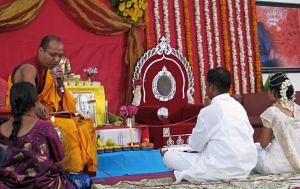
Note that the letter suggests that it is not important who conducts the ceremony as long as the mangal sutta is recited. To conduct the ceremony, one does not have to be a monk (or bhante, as they are called in Maharashtra). But they must be a virtuous person.
Fifty-year-old Mahendra Kamble of Pune, who has conducted over 150 marriage ceremonies in the last 15 years, agrees.
“The beauty of the ceremony is that any virtuous person can conduct the marriage ceremony. There is no restriction as such. However, most marriages in Maharashtra are officiated either by Baudhacharyas [from Bharatiya Bauddha Mahasabha], Dhamacharis [from Trailokya Bauddha Mahasabha] or Bhikkus [monks]. The first two are common people and not monks,” he says.
‘Not a profession, a social duty’
Kamble has completed his Baudhacharya certification from the Bharatiya Bauddha Mahasabha, formed by Ambedkar in 1954 (and registered in 1955). He carries booklets of the guide to conducting Buddhist marriage, death and other important ceremonies. But he is flexible depending on the situation.
During the wedding season, Kamble’s weekends remain busy. When he gets calls from hosts to conduct the marriage ceremony, he asks them to bring a list of simple things – photos or statues of Ambedkar and Buddha, flowers, candles and a table to put all these things at a decent height.
He attends the wedding wearing plain white shirts and trousers and manages and arranges his own travel. He takes whatever the hosts offer.
“It is not a profession for me but a social duty to spread Buddhism as per Dr Ambedkar’s wish of making India Buddhist,” he says.
And Kamble isn’t the only one – thousands of common people like him are Baudhacharyas.
The event begins with lighting candles in front of photos of Ambedkar and Buddha, followed by the recital of five precepts of Trisaran Panchasil – pledges not to harm living beings, steal, engage in sexual misconduct, false or harmful speech, or be intoxicated. The couple holds one end of the white thread, after which there is Buddha Puja and Bhimsmaran (praise of Ambedkar). The marriage officiant then recites the Paritran Path, which protects from misfortune or danger. This is followed by the Mahamangal Sutta verse, a discourse of the Buddha describing wholesome personal attainments.
The couple takes certain vows facing the audience that they will respect each other, among other things. Then, finally, Jaymangal Attagatha is recited. It recalls eight famous incidents where Buddha overcame trouble (including the ruthless Angulimala). At the end of the Jaymangal Atthagatha, the bride and groom garland each other amid a shower of flower petals and applause from the attendees. After the marriage ceremony, the couple change their clothes trading white for colourful attire for the reception. The engagement ceremony, if any, runs on similar lines except that in place of garlands, rings are exchanged.
Also read:
Flexibility is key
Having witnessed many Buddhist weddings, I can tell that no two ceremonies are identical. Flexibility is crucial in Buddhist marriages. Due consideration is given to the availability of time. While the number and sequence of suttas can change depending on time, the core remains the same – Buddha, Ambedkar and Panchashila. Before the actual ceremony, hosts do different things, like bringing the baraat (groom’s wedding brigade) on a horse, cart, or a big car, with dance and music. But the main ceremony is usually the same.
In Buddhist marriages, the concepts of muhurat (auspicious timing), panchang (hindu calendar) or kundali (horoscope matching) hardly exist. Asking for the bride and groom’s time of birth is considered rude while planning a Buddhist wedding. Also, marriages are usually conducted on weekends.
These Buddhist ceremonies are becoming more popular, sophisticated and mainstream in Maharashtra. They are serene and assertive, simple and colourful, rational and traditional.
Google Buddhist wedding, and you will see many videos with millions of views.
Also read:
A growing practice
Siddhant, a Buddhist from Nagpur who married Shweta 16 years ago in a Buddha Vihara, recalls his marriage after watching Made in Heaven. “We decided to have the wedding in a Buddha Vihara because that is what I and Shweta loved.” Their marriage was also inter-religion, with Shweta belonging to a non-Buddhist Dalit family.
Just before marriage, she took 22 vows prescribed by Ambedkar to embrace Buddhism. Shweta adds, “I have been an atheist for long, but taking the vows was an immensely liberating experience; perhaps those who are already born in Buddhist families will not understand the feeling.”
Interestingly, Siddhanth’s father, too, conducts marriage ceremonies in Nagpur. He proudly recalls one instance where his father conducted a Buddhist marriage in 1986 in Rajasthan amid tension because it was the first of its kind in the area, with many opposing the new ceremony.
Siddhant’s family is one of Nagpur’s most highly educated Buddhist families. Nagpur is a place where the Buddhist movement gained momentum following Ambedkar and Mahar community members’ conversion. Today, as per 2011 Census data, the Buddhist population in Maharashtra stands at 6.5 million.
While Nagpur was the epicentre of conversion, other parts of Maharashtra slowly followed suit. Moreover, Buddhist traditional marriages have also been reported in southern India. Karnataka’s Udupi probably witnessed its first Buddhist Marriage in 2017 when Dalita Kala Mandali Ravindra Bantakal and Kushala Kunjarugiri fulfilled their dream of having a wedding in the Buddhist tradition organised by Dakshina Kannada Bouddha Mahasabha.
With conversion, educational and economic growth has also been witnessed. According to an IndiaSpend analysis of 2011 Census data, Dalit converts to Buddhism, also called neo-Buddhists, have better literacy rates and sex ratios than the rest of the Scheduled Caste population.
The assertiveness of Buddhists is reflected in the ceremonies they conduct and insist on conducting. So, when Pallavi insists on a Buddhist wedding when her in-laws suggest they hold a traditional pheras ceremony, she fights for her identity and to prevent its erasure by dominant forces.
Prakash Ambedkar, Ambedkar’s grandson, lauded the defiance of Pallavi’s character on X (formerly Twitter):
“For those Vanchits and Bahujans who have watched the episode — Assert your identity, and only then you gain political prominence. As Pallavi puts it, ‘Everything is about the politics’. Jai Bhim.”
Ram Kumar, a founding member of Dr Ambedkar International Center (AIC) who lives in California, was born as a Hindu SC in Uttar Pradesh, where the Buddhist conversion process was slower than in Maharashtra. Kumar married in a traditional Hindu ceremony in 1996 conducted by a Brahmin priest. Slowly, he started reading Ambedkar and Buddha and was impressed by their philosophy.
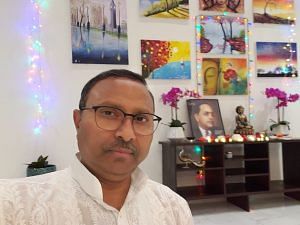
In 2005, he embraced Buddhism in New Delhi. Since then, he has been following Buddhist traditions.
“It was a new beginning for me and the family. It was as if I was finally finding our true roots. I realised that Buddhism is enriched with rationalism, and henceforth, we must follow that ideology and maintain [our] identity,” he says. Speaking from his sprawling California house, he proudly shares pictures of his living room with an Ambedkar photo and a Buddha statue, along with the paintings done by his son.
On 14 October this year, AIC will be unveiling a 12-foot-tall statue of Ambedkar near Washington DC, called the Statue of Equality. It will be the world’s tallest statue of Ambedkar. “The memorial where it will be unveiled will also have a Buddha statue and an Ashokan pillar. This will inspire many in [the] future,” says Kumar.
(Edited by Zoya Bhatti)


